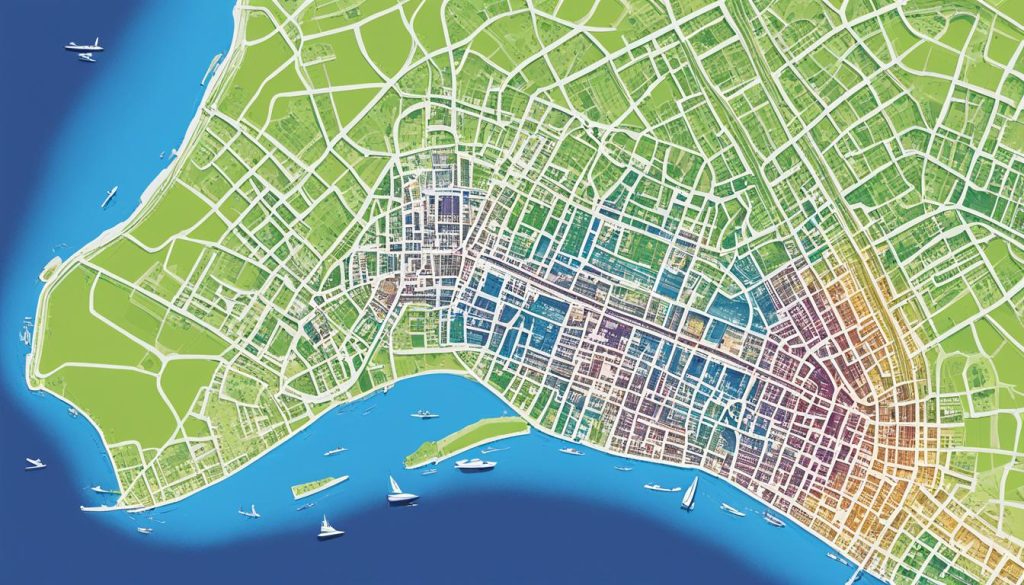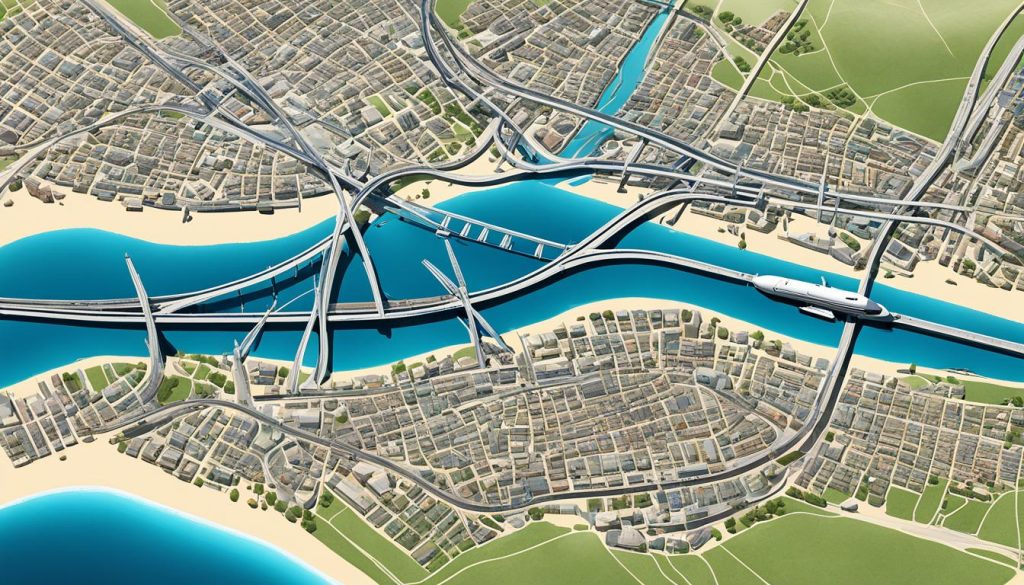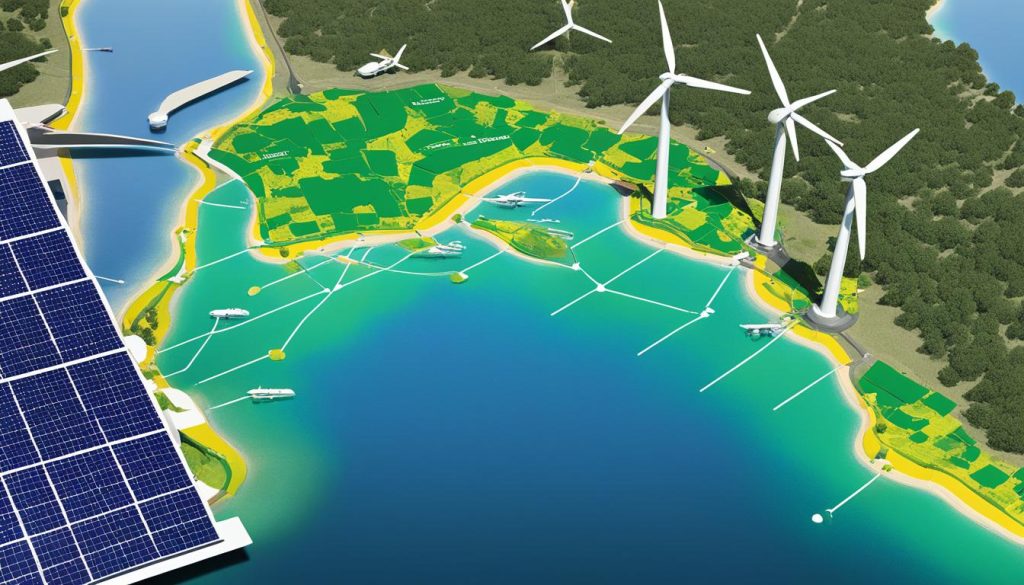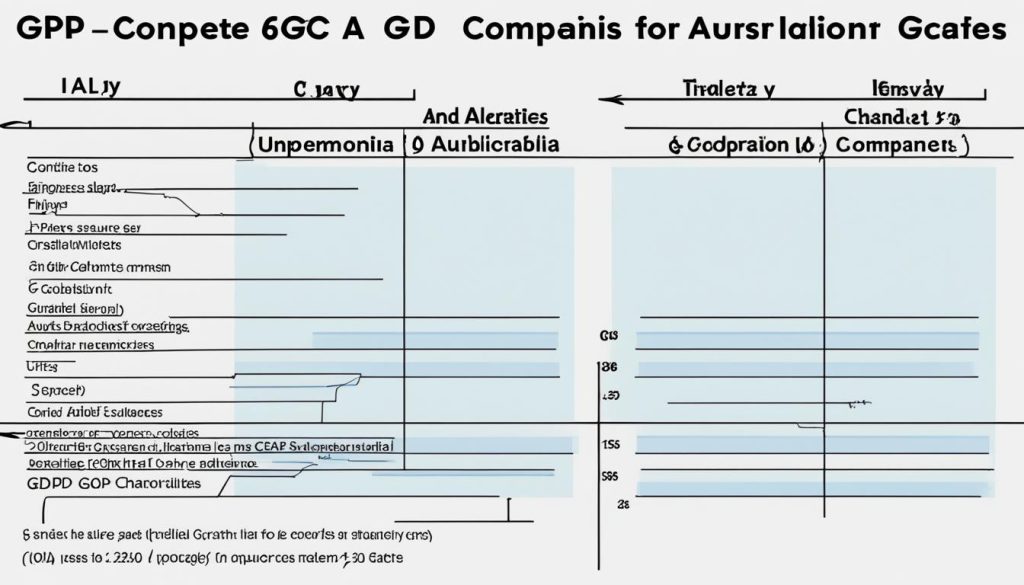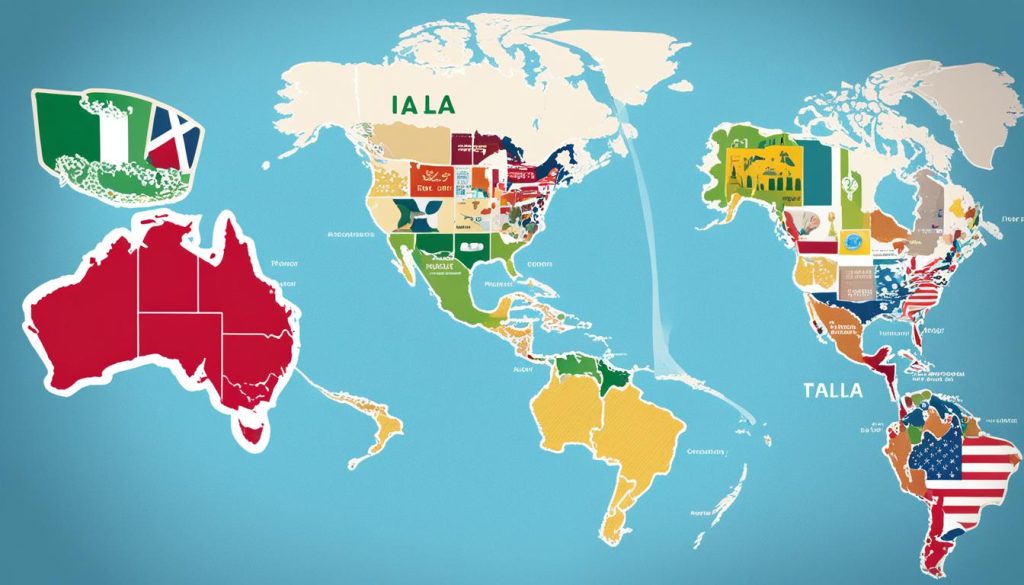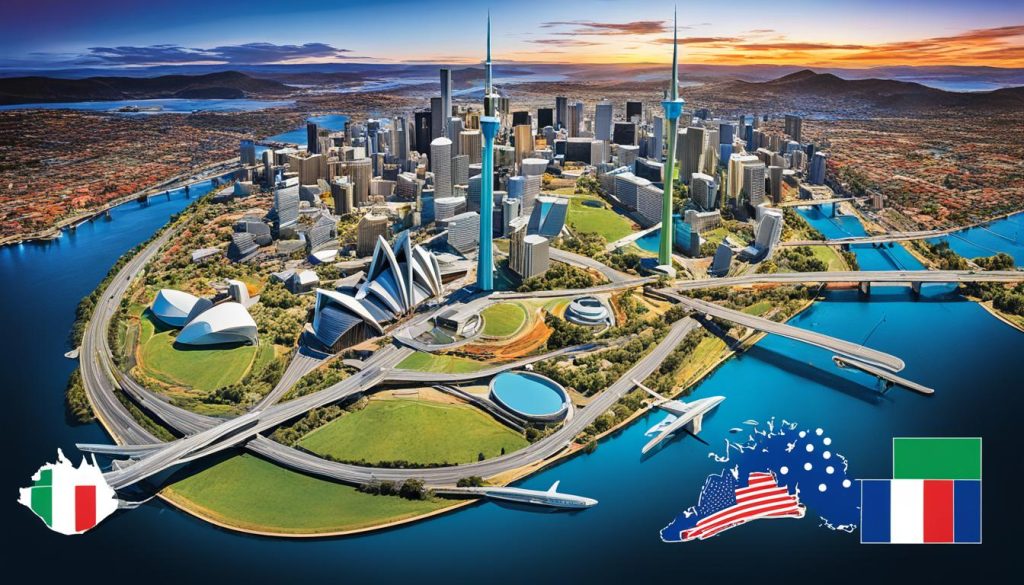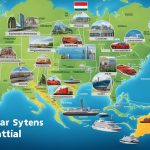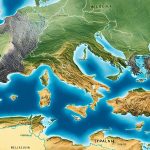The geography and infrastructure of Australia, the USA, and Italy show us their differences. These countries have diverse landscapes and have built their infrastructures differently to suit their needs. From Australia’s vast deserts to Italy’s historic sites, and the diverse USA, each place shows how its geography shapes its society.
When we look at the infrastructure of these countries, their strategies in facing environmental challenges become clear. Comparing Australia, the USA, and Italy, we see how each country has developed its urban and rural areas. This analysis offers insight into how they support their geographical and global positions.
Introduction to Geographical Diversity
The idea of geographical diversity shows how different places around the world are. From Australia’s wide spaces to the famous skylines of the USA, and the beautiful views of Italy, we see a range of diverse landscapes. These places not only give a country its shape but also form its culture and how it grows economically.
In Australia, there’s a huge area covering over 7.7 million square kilometres. It has deserts and rainforests. This large area and being far from other places make Australia really varied in its geography. Italy may be smaller but is no less varied. Its 301,340 square kilometres include mountains and beaches, offering a lot in a small space.
The USA’s wide area includes many different kinds of places. It has humid areas and freezing cold ones. These differences show how a country can adapt and be strong.
The look of these places affects more than just the view. It matters for how the countries grow, their culture, and how people live. Australia needs roads that reach far places because it’s big and not many people live there. Italy’s small size means it can have finer transport in the middle of varied lands. The USA has to connect very different places while keeping their special qualities.
- Australia’s infrastructure is made for few people and covering large distances.
- Italy’s smaller area lets it improve transport quality amidst changing lands.
- The USA builds to link very different places, like swamps and mountains.
Looking at these countries, we celebrate their beauty and how different they are. Geographical diversity shows us each nation’s unique spirit. From the Australian Outback to Italy’s lively coasts to the USA’s big canyons, the landscape shapes the life and character of a country.
Population Dynamics and Urbanisation
Population dynamics study shows trends shaped by urbanisation, age, and life in rural versus urban areas. These factors help us understand society’s changing nature. They show how we live today and how we might live tomorrow.
Demographic Structure
A nation’s demographic structure highlights its age spread, showing future prospects and issues. Australia, with its young average age, boasts a dynamic workforce. In contrast, Italy’s older age suggests greater experience but also highlights the need for strong support systems for the elderly. Both countries display high life expectancies, a nod to their healthcare efficiencies. However, Italy faces challenges with a aging population needing more care.
Rural vs Urban Populations
The move from rural areas to cities is changing our world, affecting our needs for homes, roads, and services. Australia is known for its sprawling cities and growth of suburbs, driven by the search for convenience. Italy’s historical cities show Europe’s tendency towards intensive urbanisation, making cities centres of life and activity. These patterns reflect each country’s unique strategy in managing the rise of urban living.
The Backbone of Nations: Infrastructure Overview
Exploring how Australia and Italy build their foundations shows us the impact of good infrastructure. It highlights the importance of transport systems and digital networks. These aspects are key to progress and opening doors for all citizens.
Roads, railways, and airports weave the social fabric of a nation. They’re more than concrete and steel. They reflect careful planning and investment in transport. This is essential for linking communities and boosting business.
- Australia’s roads stretch over 873,573 km, while Italy’s cover 228,863 km.
- There’s a contrast in railways too, with Australia having 32,606 km and Italy 20,048 km.
- Both countries are also focusing on digital networks. Investing in broadband and wireless technologies is crucial.
- This digital connectivity is as vital as physical roads and railways. It’s central to the global economy’s vibrancy.
- Infrastructure isn’t just about distance. It’s about effective systems that move people and goods efficiently. Both Australia and Italy exemplify this through their road and rail networks.
- With 281 airports in Australia and 55 in Italy, their transport systems meet global standards.
The differences in infrastructure between Australia and Italy go beyond size. They stem from careful strategy and vision. Both nations’ approaches to improving their infrastructure play a big role in their global competitiveness.
Surveying the Land: Area and Terrain
Our planet offers vast expanses of land, each area with its unique traits. The world’s countries differ in size and terrain diversity. A detailed landmass analysis sheds light on how landscapes affect nations and lifestyles. We’ll look at the geographical landscapes of Australia, the USA, and Italy.
Australia is immense, spanning about 7.7 million km². It’s the world’s sixth-largest country. With its deserts, rainforests, and coasts, Australia shows the broad meaning of geographical area. These varied terrains enhance Australia’s standing in a physical geography comparison.
Italy enchants with its variety of landscapes across 301,340 km². Known for its cultural wealth, Italy also boasts stunning geography. From Mediterranean shores to the Alps, Italy’s diverse landscapes not only create beautiful views. They also shape its farming and economy.
The USA offers nearly every landscape one can imagine. Its vast lands cover numerous terrains, though exact sizes aren’t given here. From deserts to forests, and mountains to plains, the USA illustrates landmass analysis on a grand scale. This nation, stretching from Alaska’s cold to Hawaii’s warmth, shows North America’s grandeur.
Understanding these geographical details helps us see their unique stories. By exploring these lands, we see how landscapes influence climates, farming, and even cultures. Each area, big or small, adds to our world’s diverse geography.
Navigating the Countries: Transportation Networks
Looking at a country’s transport tells us a lot about its growth and how people move around for local journeys. Roads and railways are big parts of how well a country can handle travel within its borders.
In Australia, the country’s size is matched by its massive transport networks. Its roads stretch over 873,573 km, making it easy to travel and do business across the land. Australia’s railways are also extensive, covering 32,606 km, which helps connect distant areas, vital for both travel and the economy.
- The scope of Australian roadways enabling widespread access and mobility.
- Railway infrastructure contributing to an interconnected metropolitan and regional framework.
- Airport facilities that support internal and international movement, numbering 281.
- Waterways used for both commercial transport and tourism, covering 2,000 km.
Now, looking at Italy, its transport system has to fit its own unique shape and packed cities. Its roads, totaling 228,863 km, support a dense population, making frequent short-distance travel easy. Italy’s railways, stretching 20,048 km, are crucial for everyday travel, efficiently connecting smaller areas.
- Italy’s interconnected road systems promoting extensive domestic commutes.
- Well-structured rail networks serving as a backbone for public transport.
- A more limited number of airports, with Italy housing 55, reflecting its geographical size.
- Waterways totalling 1,562 km that play a role in the Italian transport matrix.
The mix of roads, railways, and other transport forms shows the varied travel needs and infrastructure challenges in Australia and Italy. Understanding these systems helps us see how they back economic activities, link communities, and handle the movement of people and goods sustainably.
Energy and Resource Management
Modern governance now puts a strong focus on energy management. It’s about using resources well today and planning for the future. Nations are examining their energy production data and consumption patterns. They aim to understand and boost their energy use.
Energy Production and Consumption
Australia and Italy are closely watching their energy situations. Australia produced 249,996.1 GWh but used slightly less, at 237,388.3 GWh. This shows they manage their energy needs well. Italy, however, makes 271,877.0 GWh but uses more, 286,375.0 GWh. This means Italy must import cleaner energy to meet demands.
Renewable Energy Initiatives
Moving to renewable energy and green technology is key for the future. Australia and Italy are working on this. They want to cut their high CO2 emissions—Australia has 379.00 million tonnes and Italy has 281.29 million tonnes. Their move to clean power sources supports the worldwide push for more green actions. Though details are vague, there’s a clear trend towards sustainable energy.
- Integration of solar and wind power to reduce carbon footprint
- Investments in hydro and geothermal resources as stable, reliable energy supplies
- Innovative strategies for improving energy efficiency and reducing waste
This change highlights a big move in dealing with energy today. Countries are focusing on future-ready strategies for global energy use.
Scaling the Peaks: Comparing Economic Indicators
When we look into the economic indicators like economic performance, GDP comparison, and income levels, we get to see how healthy a nation’s economy is and how wealthy its people are. Comparing these aspects across countries shows us how well different economic policies work. It also tells us about the social wellbeing of the people there.
-
Economic Performance: Australia shines with its economic performance. It has a low unemployment rate of 3.7%. This suggests it has a lively job market offering plenty of opportunities for its people.
-
GDP Comparison: Looking at GDP, Australia’s stands at approximately $1.69 trillion USD. In contrast, Italy has a larger economy with $2.05 trillion USD. This shows the economic strength and global position of each country.
-
Income Levels: Income levels tell us about a country’s living standards. Australia’s average income is a significant $60,840. On the other hand, Italy’s average income is $38,200. This shows the differences in wealth and opportunities available to their citizens.
-
Economic Indicators: Delving deeper into economic indicators reveals the financial differences between the nations. These differences also impact the cost of living and the overall wealth of the society.
Getting to grips with these economic facts is key for those making policy and investment decisions. It helps them plan economically and make choices about investing across borders.
An In-Depth Look at Healthcare Systems
When we talk about healthcare systems, it’s key to look at both the treatments offered and the medical infrastructure foundation. This foundation helps a country efficiently care for its people. Australia and Italy provide great examples. We must compare their healthcare by looking at hospital beds and physician availability. These factors are crucial for effective and efficient medical services for citizens.
Australia shows its healthcare commitment by having 3.84 hospital beds per 1,000 people. This high number helps the nation face health emergencies and challenges well. There are also 4.10 physicians for every 1,000 people. This indicates a strong medical team ready to address Australians’ health needs and deliver thorough care.
Italy also values accessible healthcare, providing 3.14 hospital beds for every 1,000 inhabitants. Compared to Australia, Italy has fewer beds but more doctors – 4.13 for every 1,000 people. This shows both countries prioritize a significant healthcare workforce. It ensures patients receive the care they need without delay.
- Both countries stress medical infrastructure as crucial to their healthcare systems.
- Having enough hospital beds and skilled doctors improves care quality and accessibility.
- Australia and Italy both have strong healthcare, though they allocate their resources differently.
The strength of a healthcare system lies in the balance of resources—sufficient beds for the sick and skilled doctors for care. Australia and Italy show this balance well. Their healthcare systems are robust and flexible, ready to answer their societies’ health needs.
Analysing Technological Connectivity
In today’s world, a country’s technological infrastructure shows its growth level. It includes things like the telecommunication network we use every day. It also covers the digital connectivity needed for worldwide business. By looking at Australia and Italy, we see different levels of tech progress.
In Australia, mobile subscriptions are more than the people living there. This shows a full spread of mobile tech. The internet access quality shows the nation’s effort in keeping a strong telecommunication network. This network is vital for both personal and business digital talks.
- Over 28 million mobile cellular subscriptions hint at a highly connected society.
- Close to 25 million internet users demonstrate the high value placed on internet access.
Italy, on the other hand, also shows deep digital age integration. It has a huge number of mobile users. This means Italians are enjoying a well-developed telecommunication network. And they live a lifestyle that leans heavily on digital and mobility.
- Approximately 78 million mobile subscriptions mirror a society where connectivity is essential.
- Around 50 million internet users, a testament to pervasive digital connectivity across the nation.
The tech state in both countries highlights their focus on infrastructure quality. Such infrastructure is key to economic growth, education, social engagement, and global competition. So, the core of a nation’s technological infrastructure is crucial for its path ahead.
Quality of Life and Cost of Living Contrast
How happy a population is can hinge on the balance between what it costs to live and the quality of life. Australia and Italy both promise great lives but at different costs and benefits. Comparing their expenses sheds light on how living costs impact the day-to-day life of their people.
Living Expenses
In Australia, living costs are on the higher side globally. Conversely, Italy offers a lower cost of living, famed for its cultural and culinary heritage. The most striking differences are in housing, transport, and everyday needs. Public services help ease these costs, showing how valuable they are in making life affordable.
Healthcare and Education
Healthcare and education are key for a country’s reputation. Both Italy and Australia believe in strong healthcare, as seen in their hospital and doctor numbers. They also focus on education, ensuring their youth are well-prepared for the future. This reveals their commitment to bettering personal and national growth.
- Australia’s healthcare provides good services, but this can affect how affordable life is there.
- Italy prides itself on high-quality healthcare, a vital part of its national pride.
Both countries are dedicated to strong social services, especially in education and healthcare. These efforts keep living standards high, showcasing the importance of good public services in Australia and Italy.
Delving into Climate and Environmental Conditions
Comparing the climate comparison between Australia and Italy shows big differences. Australia enjoys lots of sunshine and higher temperatures. In contrast, Italy has more moderate sunshine hours.
Because of this, Australia and Italy have different environmental conditions. This leads to unique weather patterns and lifestyles in each country.
Italy usually has more humidity and rainfall than Australia. This affects how their climates feel day to day. It also impacts their natural ecosystems.
The Daintree Rainforest in Australia and Italy’s Po Delta are good examples. These places show why it’s important to understand climate for nature’s balance.
- Australian Sunshine: Embracing the Outdoors
- Italian Humidity: A Pillar of Rich Agricultural Lands
- Rainfall Patterns: Nourishing Diverse Habitats
In both countries, the environmental conditions differ greatly. Australia has areas that are very dry, and Italy has cool mountains. These conditions shape what you can experience there.
- Impact on Indigenous Cultures and Practices
- Role in Shaping Regional Agronomy
- Influence on Eco-Tourism Opportunities
The big climate differences between Australia and Italy affect everyday life. They are crucial for supporting the varied natural ecosystems in both places. This makes them interesting for those who love learning about the environment.
Comparing Politics and Governance
The base of any society lies in its political stability and how it governs. It also depends on the strength of its democracy and the freedoms given to its people. Looking at Australia and Italy, we see clear differences. These stem from their unique histories and social setups.
In Australia, a parliamentary democracy keeps politics stable. This stability is due to a good governance system that balances power well. With a political stability index of 89, Australia shows a strong, steady political backdrop. Its civil liberties score is 94, showing a place where freedoms are highly valued and protected.
- Governance Forms: Australia has a constitutional monarchy. This model shares governance between an elected government and a hereditary monarch.
- Democratic Institutions: Australia’s democracy is strong because of its two-chamber parliament and an independent judiciary. This setup checks and balances power, blocking abuse.
- Civil Liberties: Australia values individual rights, speech freedom, and law rule, showing its focus on civil freedoms.
Italy uses a parliamentary republic system, valuing public involvement and responsibility. Italy’s political stability index is 64, less than Australia but still good for democracy. It scores 66 in civil rights, lower but still focused on keeping certain freedoms within a complex political scene.
- Parliamentary Republic: Italy’s governance has a president as state head and a prime minister as government head. This encourages stability and democracy.
- Democratic Institutions: Italy’s democracy features power concentration within its parliament. This enables effective legislation and governance.
- Civil Liberties: Italy is dedicated to civil liberties despite challenges from economic issues and social change. These tests sometimes push the limits of these freedoms.
In summary, both countries have developed unique governance styles based on their cultural and historical backdrops. Their commitment to maintaining political stability, supporting democracy, and safeguarding civil liberties shows the importance of these values in a progressive society.
Evaluating Commercial Taxes and Contributions
Exploring tax rates comparison shows us why commercial taxes matter so much. They shape international business and our economy. It’s key for companies to follow strict fiscal policies. This helps them make the most of worldwide economic opportunities. Countries like Australia and Italy show this with their different cultures and economies. They highlight varied tax approaches and commercial contributions.
In Australia, businesses deal with taxes and contributions of 47.40%. This heavy percentage affects their financial plans and how they help the economy. Italy has a higher rate of 59.10%. This sets a different scene for companies there. These rates show each country’s economic values and how fiscal policies impact business and trade.
- Tax Rates Comparison: Seeing different tax rates helps understand business choices on investment and growth.
- Commercial Contributions: Payments to government revenue are big and vary a lot around the world.
- Fiscal Policies: Rules on taxes and government spending can encourage or deter investors.
- Economic Contributions: Through taxes, firms boost a nation’s economic health, benefitting society and infrastructure.
Such comparisons show the big impact of a country’s taxes on global trade. Australia and Italy are prime examples. Their unique economic contributions and tax setups show how fiscal policies shape market forces.
Trade and Industry: Economic Backbone
In the modern world, the balance of trade, exports, and imports are key to understanding a nation’s economic health. They offer insights into how a country performs on a global stage. Exploring these areas helps us get to grips with the complex interactions of different economic sectors.
Export and Import Statistics
Australia’s exports have reached about $464.9 billion USD, showing its strength in global markets. This figure is higher than its imports, which stand at $367.4 billion USD. It points to a strong trade balance. On the other hand, Italy reports exports of $751.1 billion USD but faces higher imports, totalling $781.0 billion USD. This difference underlines Italy’s intricate place in international trade.
Industrial Growth and Job Markets
The comparison of job rates between Australia and Italy tells us about their economic health. Australia has a lower unemployment rate, indicating a vibrant job market. It suggests steady growth and prosperity in its sectors. Italy, however, battles higher unemployment, showing its economic hurdles. The average wage in Italy is $34,071, while in Australia, it’s much higher at $66,054. This contrast highlights the differences in their economies and job scenes.
Cultural Fabric: Languages and Religions
The cultural identity of a place is deeply tied to its languages and religions. In Australia and Italy, this is very clear. Australia is a blend of many languages. English is most common, but Chinese, Arabic, and Vietnamese are important too. These languages connect people to their heritage.
Italy, on the other hand, mostly speaks Italian. This language is a key part of being Italian. But, Italy also has local dialects and traditions. These add variety to the Italian cultural scene.
Religion adds another layer to cultural identity in these countries. Christianity is big in both, but they treat secularism and other religions differently. Australia is quite diverse in religions. It has many non-denominational people and followers of Buddhism, Islam, and more. This shows a society that accepts many beliefs.
- About 76.8% of Australians mainly speak English. But many also speak Chinese, Arabic, Vietnamese, and more.
- Italy is mostly Italian-speaking, at 94.1%. Also, 91.6% of Italians follow Christian beliefs.
- Australia’s faith landscape shows a mix. It includes Christianity and other religions, plus non-denominational beliefs.
Understanding language and religion differences helps us see the depth of societies. These elements are crucial in connecting and understanding people worldwide. They show us the beauty and complexity of our global community.
Compare Geography and Infrastructure Between Australia, USA, and Italy
The world’s dynamics are greatly shaped by a nation’s strategic location. This gives a major geographic advantage that influences its economic gains and problems. Australia and Italy are in different parts of the world, while the USA has varied landscapes. These factors give them unique positions and challenges in global affairs.
Strategic Geographic Positions
Australia benefits from being in the Southern Hemisphere, offering it distance and uniqueness. Oceans around it act as natural barriers and paths for trade. This position has pushed Australia to develop its infrastructure, helping improve its role globally. On the other hand, Italy, in the Mediterranean’s center, connects Europe, Africa, and the Middle East. This gives Italy major logistical and cultural benefits.
Infrastructure Capabilities and Innovations
Infrastructure is key for growth and well-being. Australia and Italy use innovative technologies to boost their infrastructure. Australian cities aim to become smart cities, adding sustainable and digital structures. Meanwhile, Italy’s old cities get modern updates, mixing history with new tech.
Both countries take part in development projects to improve connections and efficiency. They introduce renewable energy and fast transport systems. These efforts show they value sustainable and forward-thinking infrastructure.
The mix of old infrastructure and new technology shows how Australia and Italy are adapting. They are working towards infrastructure that is strong and meets modern needs. This highlights a global shift towards more sustainable and innovative infrastructure approaches.
Conclusion
In this discussion, we looked at how geography, people, and infrastructure make Australia, the USA, and Italy unique. We compared these countries, showing how their size, population, and systems connect them to their land. Each one adds to a detailed study, showing their differences and similarities in the world.
This comparison sheds light on each nation’s challenges and successes. Australia’s vast lands require creative infrastructure for its remote areas. Italy’s rich history is reflected in its intricate public works. Though not deeply covered here, the USA’s diverse landscapes and systems were also considered. These examples help us grasp how each country operates socially and economically.
Looking at their global positions and development paths, Australia, the USA, and Italy display unique strengths. They each use technology, manage resources well, and focus on their people’s welfare. These efforts are lessons in innovation and adjustment. In the end, we see how these countries are planning their futures, shaped by their geographies, populations, and ambitions to evolve.



